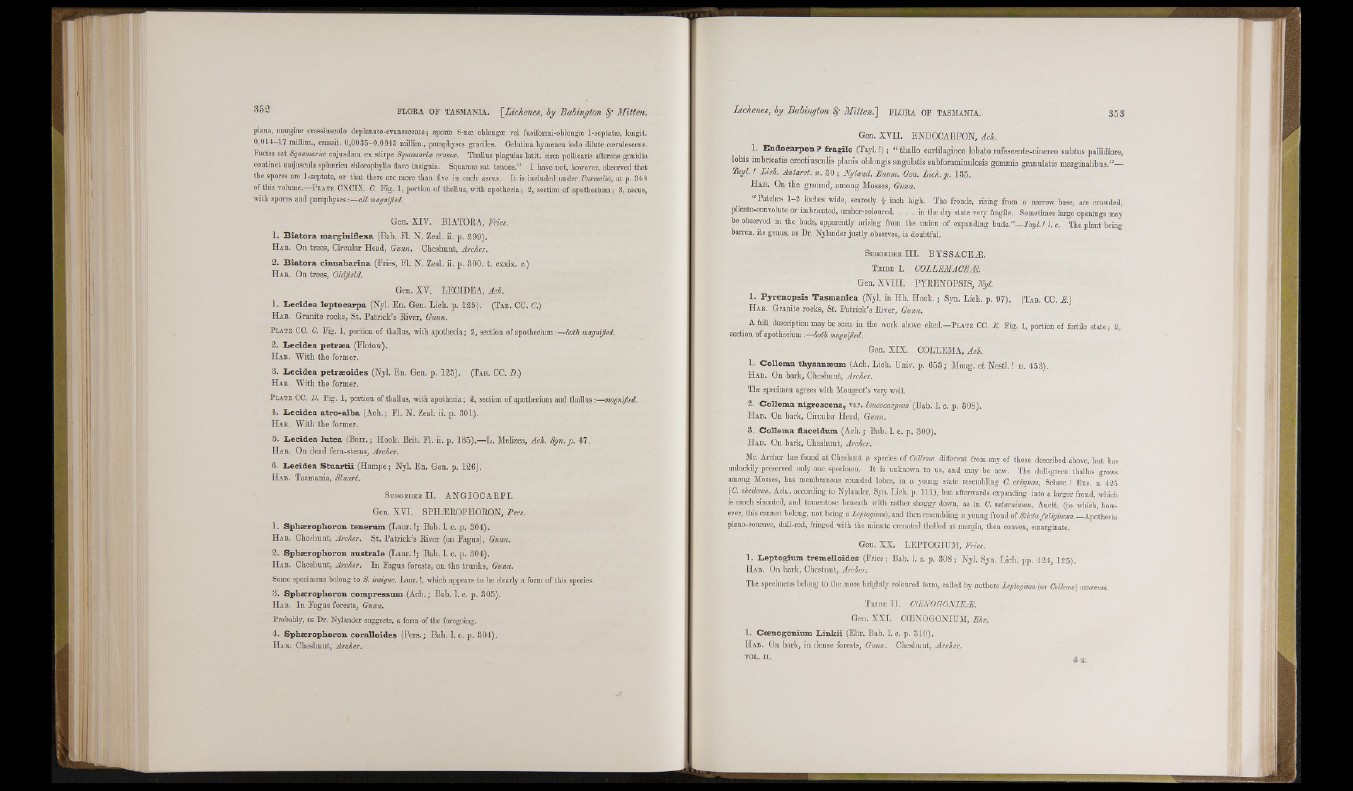
plana, margine crassiusculo deplanato-evanescente ; sporte 8-næ oblongæ vel fusiformi-oblongæ 1-scptatoe, longit.
Û,0U-17 millim., crassit. 0.0035-0,0045 millim., paraphyses graciles. Gelatina hymenea iodo dilute cærulescens.
Facies est Sqnamarioe cujusdain ex stirpe Squamarioe erassæ. Thallus plagrdas latit. circa pollicaris afterens gonidia
continet majuscula sphærica chlorophyllo flavo insignia, Squamæ sat tenues” I have not, liowever, observed thnt
the spores arc 1-septate, or that there are more than five in each ascus. It is included under Parmelia, at p. 348
of this volume.—P l a t e CXCIX. C. Fig. 1, portion of thallus, with apothecia ; 2 , section of apothecium ; 3, ascus,
with -spores and paraphyses:—«// magnified.
1. Biatoi
Gen. XIV. BIATORA, Fries.
I (Bab. f l . N. Zeal. ii. p. 299).
H a b . On trees, Circular Head, Gunn. Cheshunt, Archer.
2. B ia to ra cinnabarina (Fries, Fl. N. Zeal. ii. p. 300. t. cxxix. e.)
H a b . On trees, (
Gen. XV. LECIDEA, Ach.
1. L e c id ea lep tocarpa (Nyl. En. Gen. Lich. p. 125). (T a b . CC. C.)
H a b . Granite rocks, St. Patrick’s River, Gunn.
P late CC. C. Fig. 1, portion of thallus, with apothecia; 2, section of apothecium ;—both magnified.
2. L ecid ea petraea (Flotow).
H a b . "With the former.
3. L e c id ea petraeoides (Nyl. En. Gen. p. 125). (Ta b . CC. i ) . )
H a b . With the former.
Plate CC. 2). Fig. 1, portion of thaDus, with apothecia; 2, section of apothecium and thallus:—magn
4. Le c id ea atro-alba (Ach.; Fl. N. Zeal. ii. p. 301).
H a b . With the former.
5. Lecid ea lu tea (Borr.; Hook. Brit. Fl. ii. p. 185).—L. Melizea, Ach. S yn .p . 47.
H a b . On dead feni-stems, Areher.
6 . L e c id ea S tu a rtii (Hampe; N y l En. Gen. p. 126).
H.vb. Tasmania, Sluart.
S u bo r d er II . A N G IO C A R P I.
Gen. XVI. SPHiEROPHORON, Pers.
I. Spbseropboron tenerum (L a u r.!; Bab. 1. c. p. 304).
H ab. Cheshunt, Archer. St. Patrick’s River (on Fagus), Gunn.
2. Sphseropboron au strale (Laur.!; Bab. 1. c. p. 304).
H a b . Cheshunt, Archer. In Fagus forests, on the trunks, Gunn.
Some specimens belong to S. insigne, Laur.!, which appears to be clearly a form of this species.
3. Spbaeropboron compressum (Ach.; Bab. 1. c. p. 305).
H a b . In Fagus forests, Gunn.
Probably, as Dr. Nylander suggests, a form of the foregoing.
4. Spbaeropboron coralloid es (Pers.; Bab. 1. c. p. 304).
H ab. Cheshunt, Archer.
Gen. XVII. ENDOCARPON, Ach.
1. Bnd o ca rpon ? fragile (Tayl.!); “ thallo cartilagíneo lobato rufescente-cinereo subtus pallidiore,
lobis imbricatis erectiusculis planis oblongis angulatis subforaminulosis gemmis granulatis marginalibus.”—
Tayl. ! Lich. Antarct. n. 30 ; Nyland. Enum. Gen. Lich. p . 135.
H a b . On the ground, among Mosses, Gunn.
“ Patches 1 - 2 mches wide, scarcely i inch high. The fronds, rising from a narrow base, are crowded,
plicato-convolute or imbricated, umber-coloured, . . . in the d iy state v c iy fragüe. Sometimes large openings may
be observed in the buds, apparently arising from the union o f expanding bu ds.”— % / . / /. c. The plaut being
barren, it s genus, as Dr. Nylander justly observes, is doubtful.
S u bo r d er I I I . BYS SAC EJ3 .
T r ib e 1. COLLEMACEJE.
Gen. X V III. PYRENOPSIS, Nyl.
1. p y r e n o p s is T a sm a n ic a (Nyl. in Hb. Hook.; Syn. Lich. p. 97). (Ta b . CC. E.)
H a b . Granite rocks, St. Patrick’s River, Gunn.
A full description may be seen in the work above cited.— P late CC. E. F ig . 1, portion o f fertüe s ta te ; 2,
section o f apothecium:— both magnified.
Gen. XIX. COLLEMA, Ach.
1. CoUema tbysanaeum (Ach. Lich. Univ. p. 653; Moug. et N e s tl.! n. 453).
H a b . O u bark, Cheshunt, Archer.
The specimen agi-ees with Mougeot’s veiy weU.
2. Collema n ig r e sc en s, var. leucocarpum (Bab. 1. c. p. 308).
H a b . O n bark. Circular Head, Gunn.
3. Collema flaccidum (Ach.; Bab. 1. c. p. 309).
H a b . On bark, Cheshunt, Archer.
Mr. Ai-cher has found at Cheshunt a species o f Collema different fi-om any o f those described above, but has
unlucküy preserved only one specimen. I t is unknmvn to us, and may be new. The dull-green thallus grows
among Mosses, has membranous rounded lobes, in a young state resembling C. crispum, S cb ie r .! E x s. n. 42 5
(C, cMleum, Ach., accordmg to Nylander, Syn. Lich. p. I l l ) , but aftenvards expanding into a larger frond, which
is much sinnated, and tomentose beneath w ith rather shaggy down, as in C. saturninum, Auctt. (to which, however,
this cannot belong, no t being a Leptogium), and then resembling a yonng frond o f Sticta/« /fyw o sa ,— Apothecia
plano-concave, dull-red, fringed w ith the minute crenated thallod at margin, then convex, emarginate.
Gen. XX. LEPTOGIUM, Fries.
\ treme lloid es (Fries; Bab. 1. c. p. 308; Nyl. Syn.I. Leptogiu; Lich. pp. 124, 125).
H a b . On bark, Cliestmit, Archer.
The specimens belong to the more brightly coloured fonn, called by authors Leptogium (or Collema) azureim.
T m b e II. CaiNOGONIEJE.
Gen. XXI. CCENOGONIUM, Ehr.
1. Coenogonium L in k ii (Ebr. Bab. 1. e. p. 310).
H a b . On bark, in dense forests, Gunn. Cheshunt, Archer.